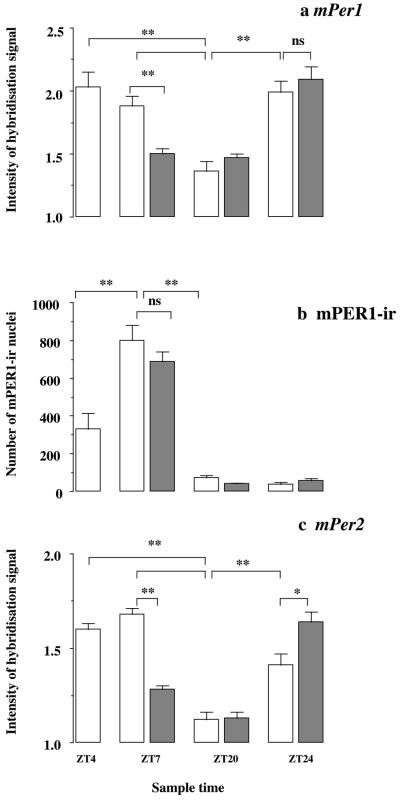Figure 4.
Resetting by a nonphotic behavioral cue causes acute suppression of mPer signals, but not mPER1-ir in the SCN, shifting the endogenous mPer2 mRNA cycle. (a) Relative intensity (mean + SEM) of the mPer1 hybridization signal in the SCN exhibits a circadian rhythm in home-cage controls (open bars) and animals confined to a novel wheel (shaded bars) (ANOVA time effect F = 33.4, P < 0.01). Overall, there was no difference between treatment groups (F = 0.9, n.s.), but a highly significant interaction between treatment and time (ANOVA interaction F = 8.7, P < 0.01), arising from a significant suppression of the hybridization signal at ZT 7, after running in the novel wheel (n = 4–7 per group, n = 35). **P < 0.01 by posthoc Bonferroni and Dunnett's t test. (b) The abundance of mPER1-ir nuclei in the SCN exhibits a highly significant circadian rhythm in both groups of animals (ANOVA time effect F = 159, P < 0.01), with a peak during the subjective day, but no treatment effect (F = 1.0, n.s.) nor interaction (F = 1.1, n.s.). **P < 0.01 by posthoc Dunnett's t test. (c) Relative intensity (mean + SEM) of the mPer2 hybridization signal in the SCN exhibits a circadian rhythm in home-cage controls (open bars) and animals confined to a novel wheel (shaded bars) (ANOVA time effect F = 70.7, P < 0.01). Overall, there was no difference between treatment groups (F = 2.9, n.s.), but a highly significant interaction between treatment and time (ANOVA interaction F = 45.5, P < 0.01), arising from a significant suppression of the hybridization signal in the treatment group at ZT 7 and a significant elevation in this group at ZT 24. **P < 0.01, *P < 0.05 by posthoc Bonferroni and Dunnett's t test.

